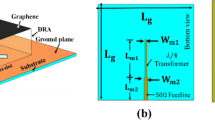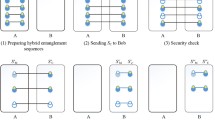Abstract
The noise modulated non-polarized communication system, developed by us recently, is an ultra-wideband transmitted-reference system designed for secure interferencefree communications. By using ultra-wideband random noise to spread the signal and by using polarization diversity for transmitting the spread message and the reference signal, we make the transmitted signal appear totally featureless and noise-like. However, the system may encounter intentional and non-intentional interference since its operating bandwidth is very large. This paper derives analytical models to characterize system performance in partial-band jamming channels and channels containing narrowband interference. Models compare very well with simulations and results validate successful system operation under low signal-to-interference ratio conditions. Research also reveals that the center frequency of transmitted signal must be suitably protected to prevent link outage due to the presence of cross-interference terms. Since multipath acts as self-interference for communication systems, a new method which can improve system performance in multipath environments is also introduced in this paper.
Similar content being viewed by others
Abbreviations
- BER:
-
Bit error rate
- BPSK:
-
Binary phase shift keying
- CDF:
-
Cumulative distribution function
- DS/SS:
-
Direct-sequence spread-spectrum systems
- FPGA:
-
Field-programmable gate array
- FSK:
-
Frequency shift keying
- GPS:
-
Global positioning system
- ISI:
-
Intersymbol interference
- LPD:
-
Low probability of detection
- LPI:
-
Low probability of intercept
- NBI:
-
Narrowband interference
- PDF:
-
Probability density function
- QPSK:
-
Quadrature phase shift keying
- SIR:
-
Signal-to-interference ratio
- SNR:
-
Signal-to-noise ratio
- PN:
-
Pseudo-noise
- PSD:
-
Power spectral density
- TR:
-
Transmitted-reference
- RF:
-
Radio frequency
- SSB:
-
Single sideband
- UWB:
-
Ultrawideband
- WSSUS:
-
Wide sense stationary uncorrelated scattering
References
Cook C. E., Marsh H. S. (1983) An introduction to spread spectrum. IEEE Communications Magazine 21(2): 8–16
Scholtz R. A. (1982) The origins of spread-spectrum communications. IEEE Transactions on Communications 30(5): 822–854
Yost R. A., Pettit R. H. (1981) Susceptibility of DS/FH, binary DPSK to partial and full band barrage jamming. IEEE Transactions on Aerospace and Electronic Systems 17(5): 693–700
Peterson R. L., Ziemer R. E., Borth D. E. (1995) Introduction to spread spectrum communications. Prentice Hall, Englewood Cliffs, NJ
Hill, P. C. J., Comley, V. E., & Adams, E. R. (1997). Techniques for detecting and characterising covert communication signals. In Proceedings of the IEEE military communications conference, MILCOM 1997 (pp. 1361–1365). Monterey, CA, November 1997.
Gardner W. A. (1988) Signal interception: A unifying theoretical framework for feature detection. IEEE Transactions on Communications 36(8): 897–906
Berber, S. M. (2006). A noise phase shift keying for secure multiuser code division multiple access systems. In Proceedings of the IEEE military communications conference, MILCOM 2006. Washington, DC, October 2006. doi:10.1109/MILCOM.2006.302427.
Berber, S. M. (2008). Fading mitigation in an interleaved noise-based DS-CDMA system for secure communications. In Proceedings of the fifth IASTED international conference on signal processing, pattern recognition, and applications, SPPRA 2008 (pp. 260–265). Innsbruck, Austria, February 2008.
Gagliardi R. M. (1964) A geometrical study of transmitted reference communication systems. IEEE Transactions on Communication Technology 12(4): 118–123
Narayanan R. M., Chuang J. (2007) Covert communications using heterodyne correlation random noise signals. Electronics Letters 43(22): 1211–1212
Haartsen, J. C., Meijerink, A., Bekkaoui, A., Taban, A., & Tauritz, J. L. (2004). Novel wireless modulation technique based on noise. In Proceedings of the 11th annual IEEE symposium on communications and vehicular technology in benelux, SCVT 2004. Ghent, Belgium, November 2004.
Kalinin, V., Panas, A., Kolesov, V., & Lyubchenko, V. (2006). Ultra wideband wireless communication on the base of noise technology. In Proceedings of the international conference on microwaves, radar & wireless communications, MIKON 2006 (pp. 615–618). Krakow, Poland, May 2006.
Haartsen, J.C., Shang, X., Balkema, J. W., Meijerink, A., & Tauritz, J. L. (2005). A new wireless modulation scheme based on frequency-offset. In Proceedings of the 12th annual IEEE symposium on communications and vehicular technology in benelux, SCVT 2005. Enschede, The Netherlands, November 2005.
Chuang, J., DeMay, M. W., & Narayanan, R. M. (2008). Design, analysis, and performance of a noise modulated covert communications system. EURASIP Journal on Wireless Communications and Networking. doi:10.1155/2008/979813.
Hamalainen, M., Tesi, R., & Iinatti, J. (2002). On the UWB system performance studies in AWGN channel with interference in UMTS band. In Proceedings of the IEEE conference on ultra wideband systems and technologies, UWBST 2002 (pp. 321–325). Baltimore, MD, May 2002.
Zhao L., Haimovich A. M. (2002) Performance of ultra-wideband communications in the presence of interference. IEEE Journal on Selected Areas in Communications 20(9): 1684–1691
Giorgetti A., Chiani M., Win M. Z. (2005) The effect of narrowband interference on wideband wireless communication systems. IEEE Transactions on Communications 53(12): 2139–2149
Giorgetti, A., & Dardari, D. (2005). The impact of OFDM interference on TH-PPM/BPAM transmission systems. In Proceedings of the 61st IEEE vehicular technology conference, VTC 2005 (pp. 1037–1042). Stockholm, Sweden, May–June 2005.
Quek T. Q. S., Win M. Z., Dardari D. (2007) Unified analysis of UWB transmitted-reference schemes in the presence of narrowband interference. IEEE Transactions on Wireless Communications 6(6): 2126–2139
Dawood M., Narayanan R. M. (2001) Receiver operating characteristics for the coherent UWB random noise radar. IEEE Transactions on Aerospace and Electronic Systems 37(2): 586–594
Aroian L. A., Taneja V. S., Cornwell L. W. (1978) Mathematical forms of the distribution of the product of two normal variables. Communications in Statistics Part A—Theory and Methods 7(2): 165–172
Goldsmith A. (2005) Wireless communications. Cambridge University Press, Cambridge, UK
Boyer P. (2004) Performance base on selective multipath reception. IEEE Transactions on Communications 52(2): 280–288
Balanis C. A. (1989) Advanced engineering electromagnetics. Wiley, New York, NY
Stüber G. L. (2002) Principles of mobile communication. Kluwer, Norwell, MA
Failli, M. (Ed.) (1989) COST 207: Digital land mobile radio communications—final report. Office for Official Publications of the European Communities, Luxembourg
Author information
Authors and Affiliations
Corresponding author
Additional information
This work was supported by the US Office of Naval Research (ONR) Grant # N00014-04-1-0640.
Rights and permissions
About this article
Cite this article
Chuang, J., Narayanan, R.M. Performance of Non-Polarized Noise Modulated Communications System in the Presence of Interference. Wireless Pers Commun 65, 773–796 (2012). https://doi.org/10.1007/s11277-011-0295-6
Published:
Issue Date:
DOI: https://doi.org/10.1007/s11277-011-0295-6




